Exclusive: Jason Pierre-Paul relives explosion that destroyed his hand

Ed. Note: The following story contains extremely graphic images that are disturbing in nature. They were all provided to Sports Illustrated directly by, and with the consent of, Jason Pierre-Paul.
This story appears in the April 18, 2016, issue of Sports Illustrated. Subscribe to the magazine here.
In the late hours of July 4, 2015, at a holiday cookout in his hometown of Deerfield Beach, Fla., Giants defensive end Jason Pierre-Paul stood on a patch of sun-beaten grass, across the street from a party where more than 50 family members and friends milled about in the nearly 90º heat. Nearby, parked on the shoulder, sat a U-Haul van. Inside, a civic contribution of sorts: He had purchased $1,100 worth of fireworks, enough for the whole neighborhood to enjoy.
Just before midnight, after an evening of shooting fireworks into the sky, Pierre-Paul decided he’d had enough. But then a friend pointed out that the U-Haul was almost empty. Shouldn’t they pop off the last few?
With his shirt off, Pierre-Paul obliged—or at least tried to. He attempted seven times to apply flame to fuse, to ignite a stick that would send a stream of colors rocketing into the night, but the wind kept blowing out his lighter. He remembers thinking, Let me try one more time. . .
Suddenly, success—and then an eruption, a bang and a blinding green-and-white light that, witnesses say, swallowed Pierre-Paul’s 6' 5", 278-pound frame. “I remember a big flash, and I heard boom!” says Farraw Germain, the mother of Pierre-Paul’s then eight-month-old son, Josiah. “There was a lot of smoke.” Pierre-Paul sensed trouble right away. “As soon as I saw the green light, I jumped,” he says. “I knew something dangerous was about to happen.”
Pierre-Paul dropped to the grass. But when he arose he smelled nothing, felt nothing. Then he heard Germain shriek in terror, “Your hand!”
(These photos, provided by Pierre-Paul, are found below, but WARNING, they are incredibly gruesome.)
EXCLUSIVE: Jason Pierre-Paul’s damaged hand
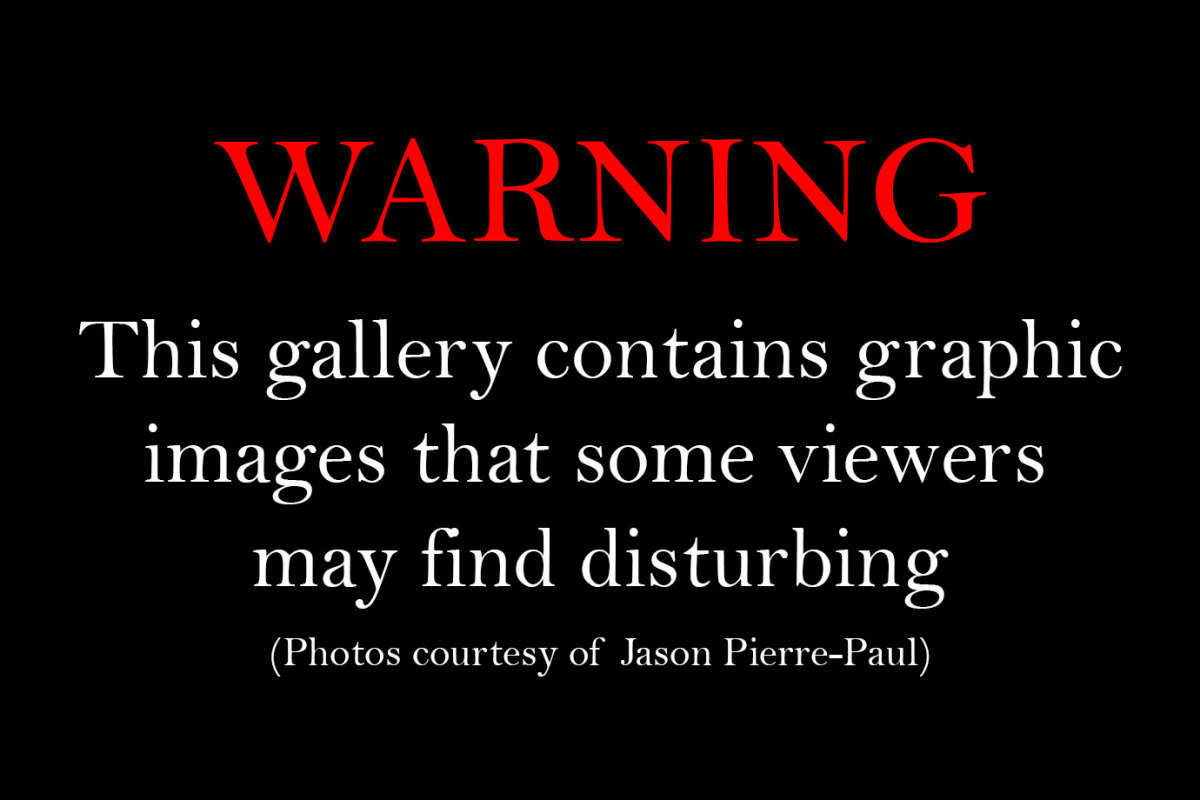
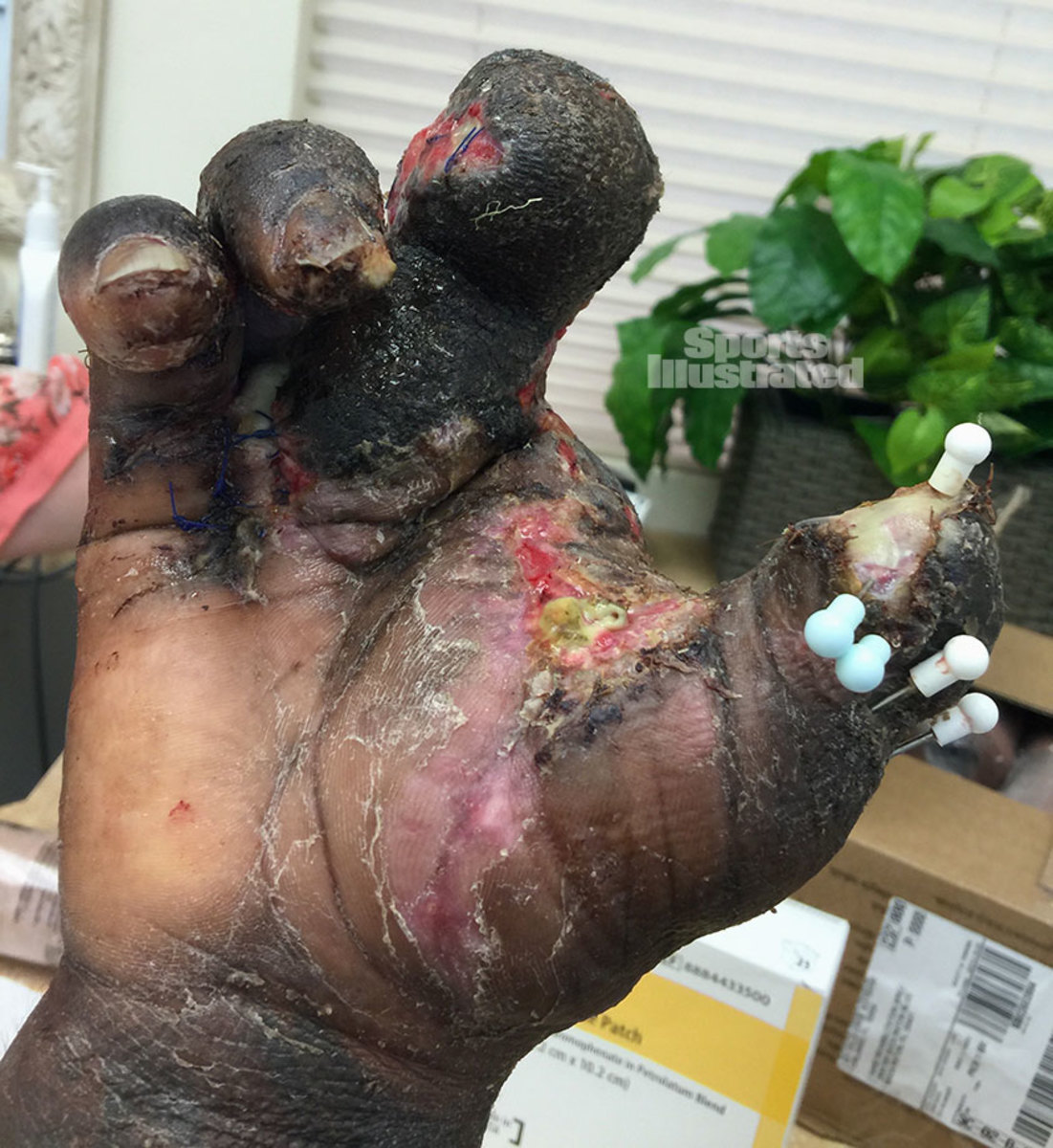
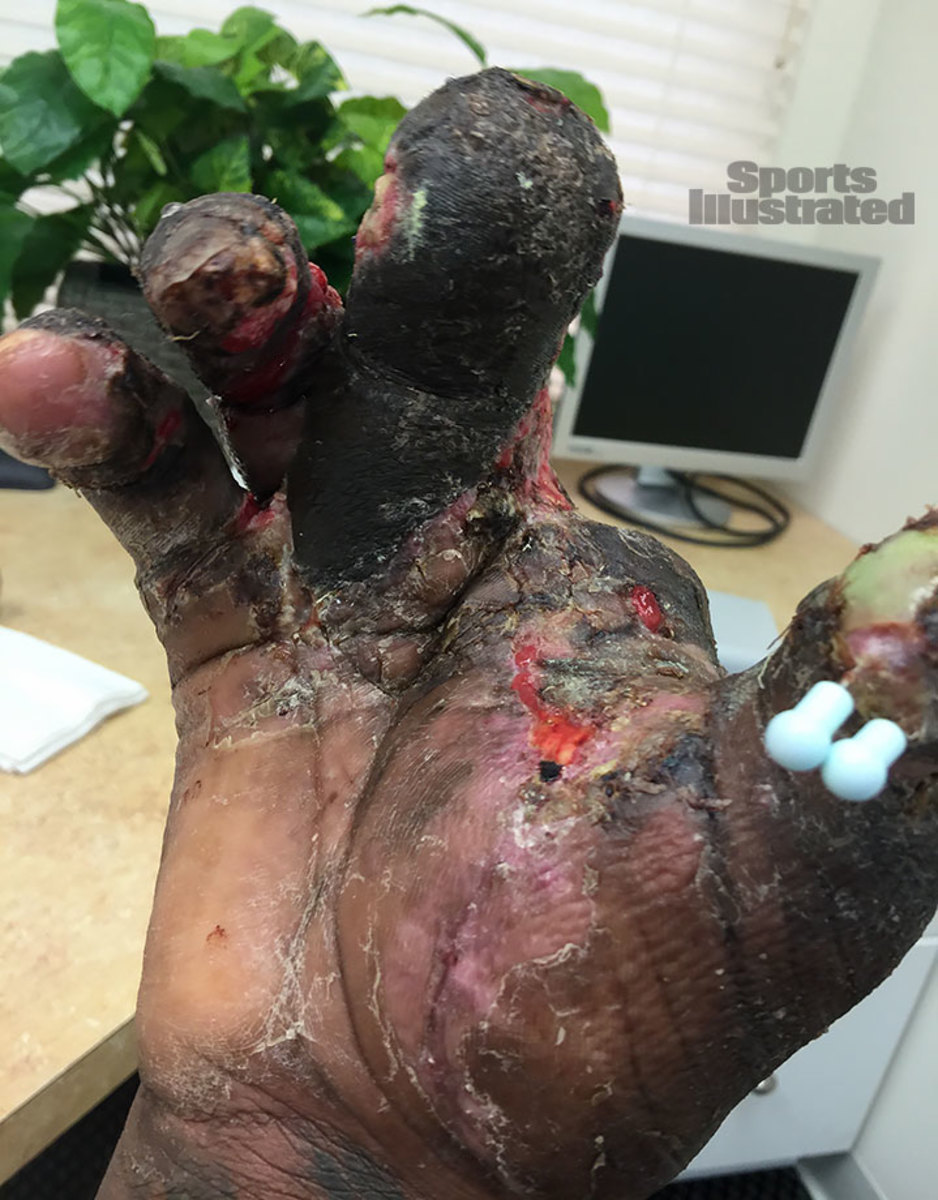
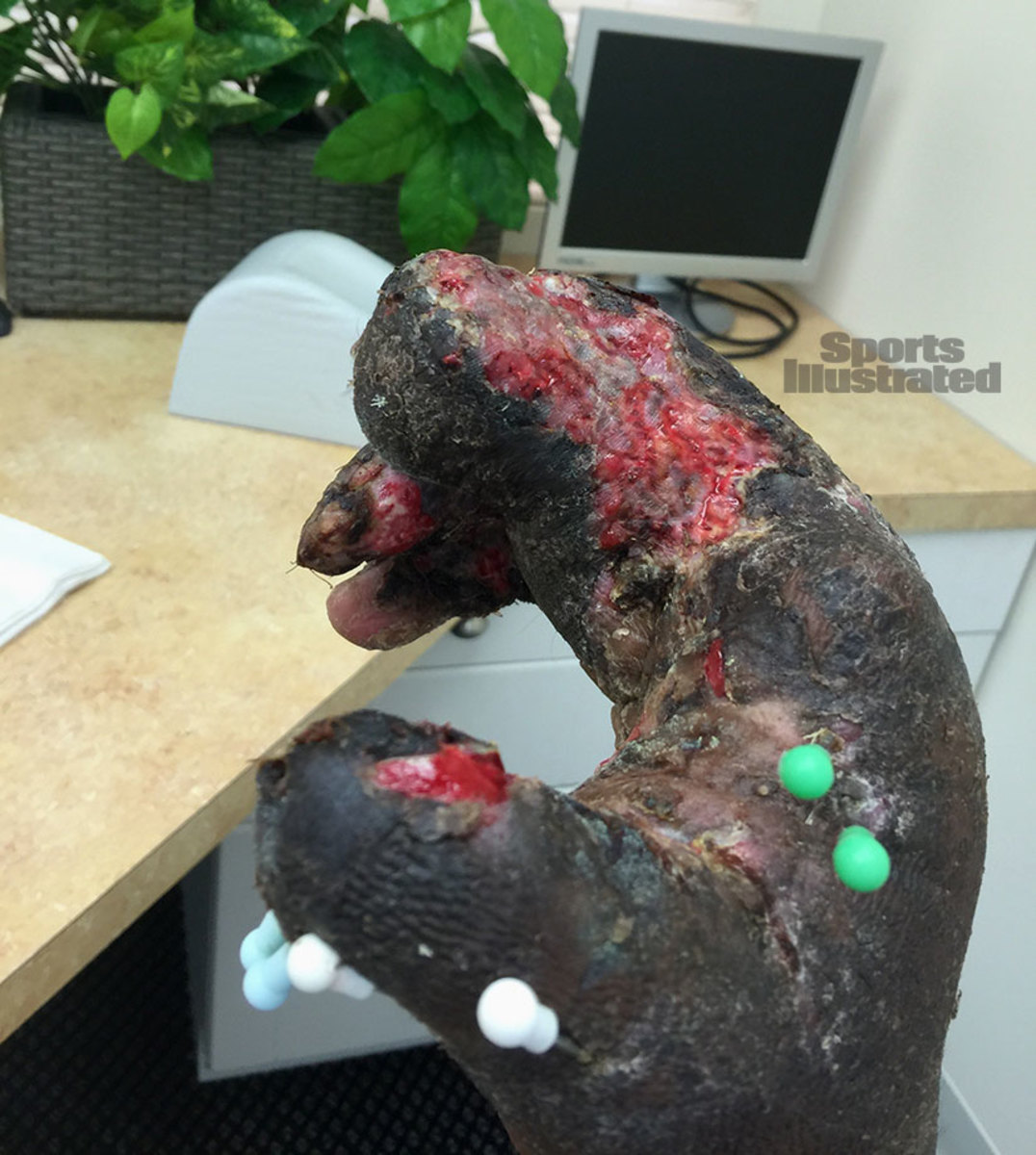
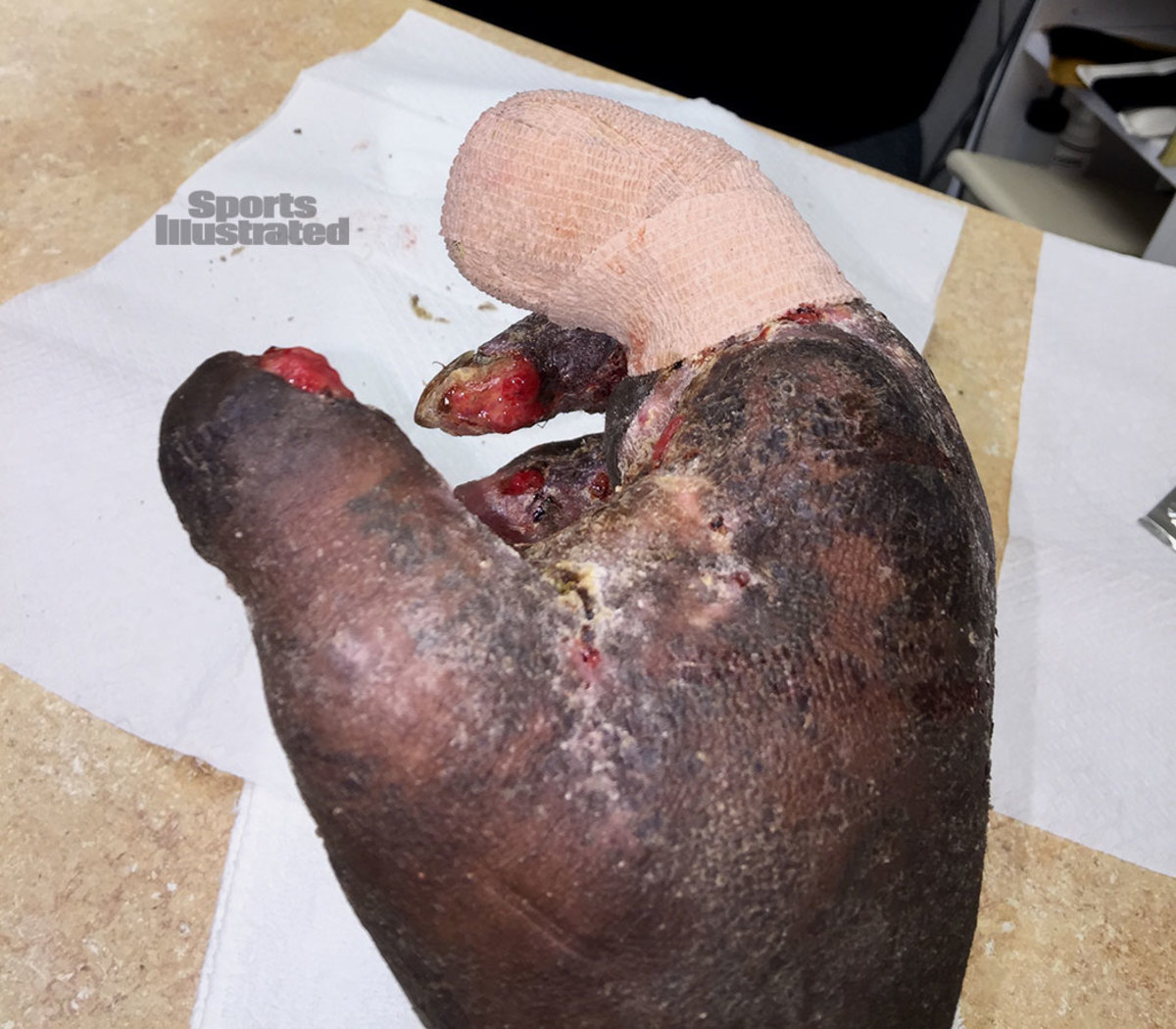
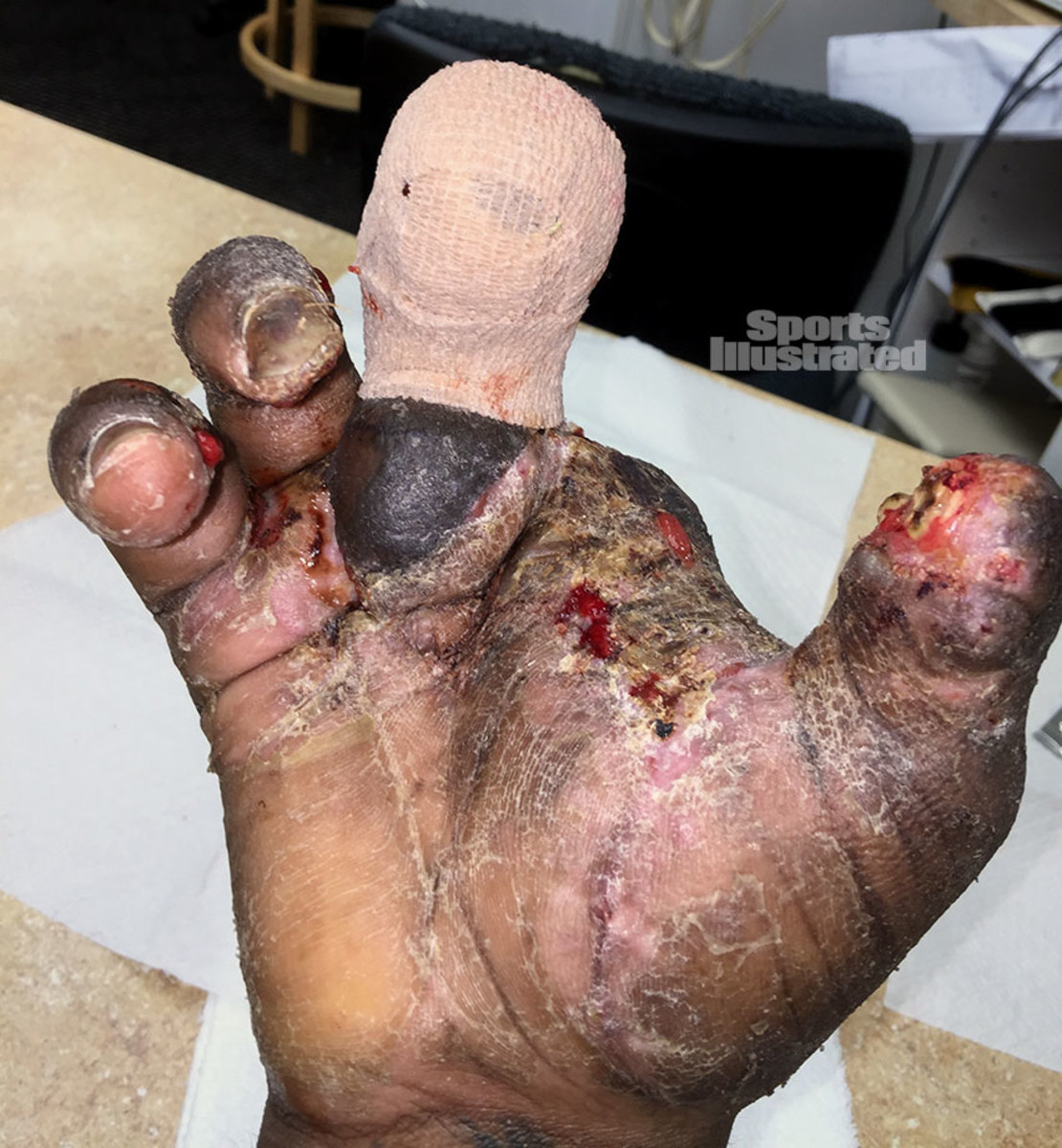
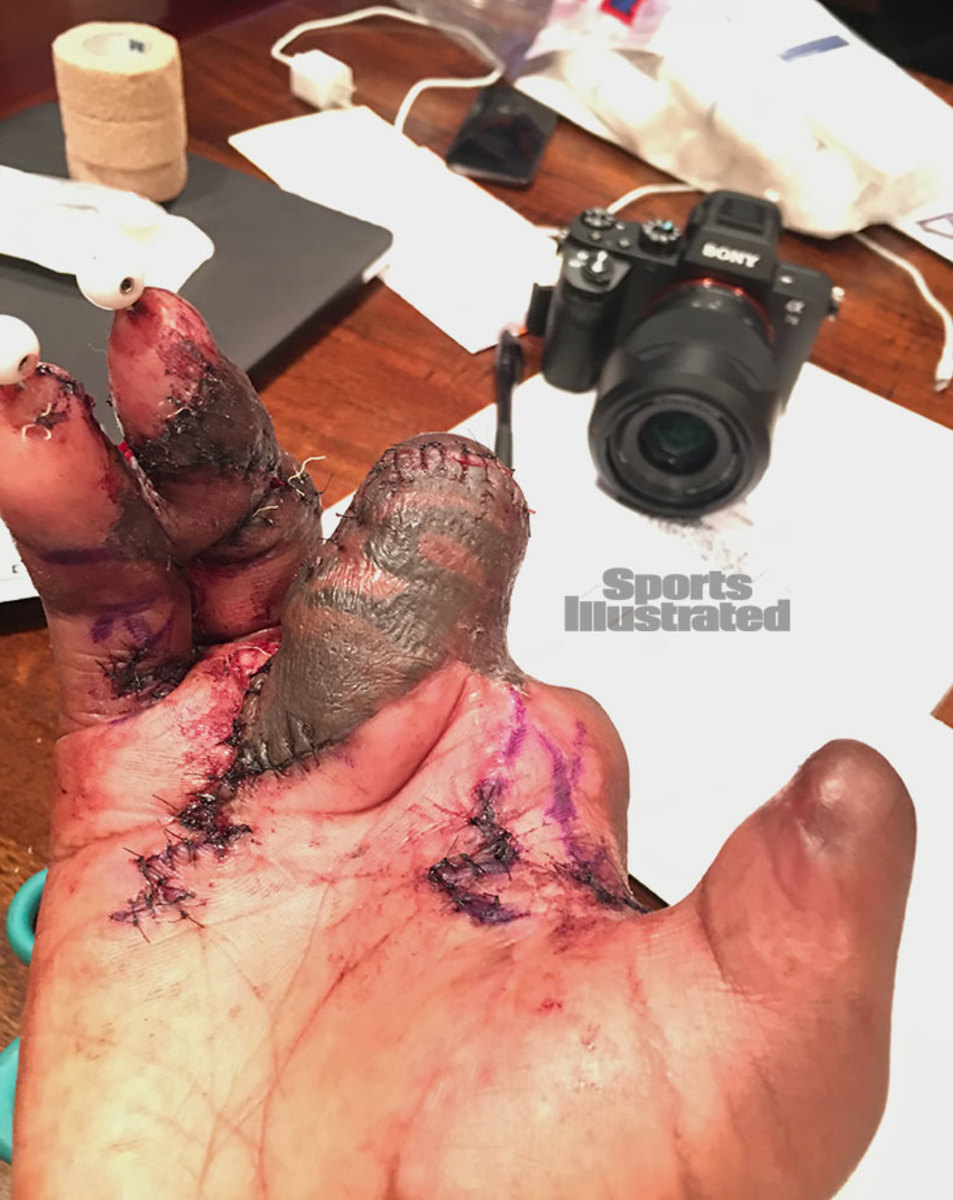
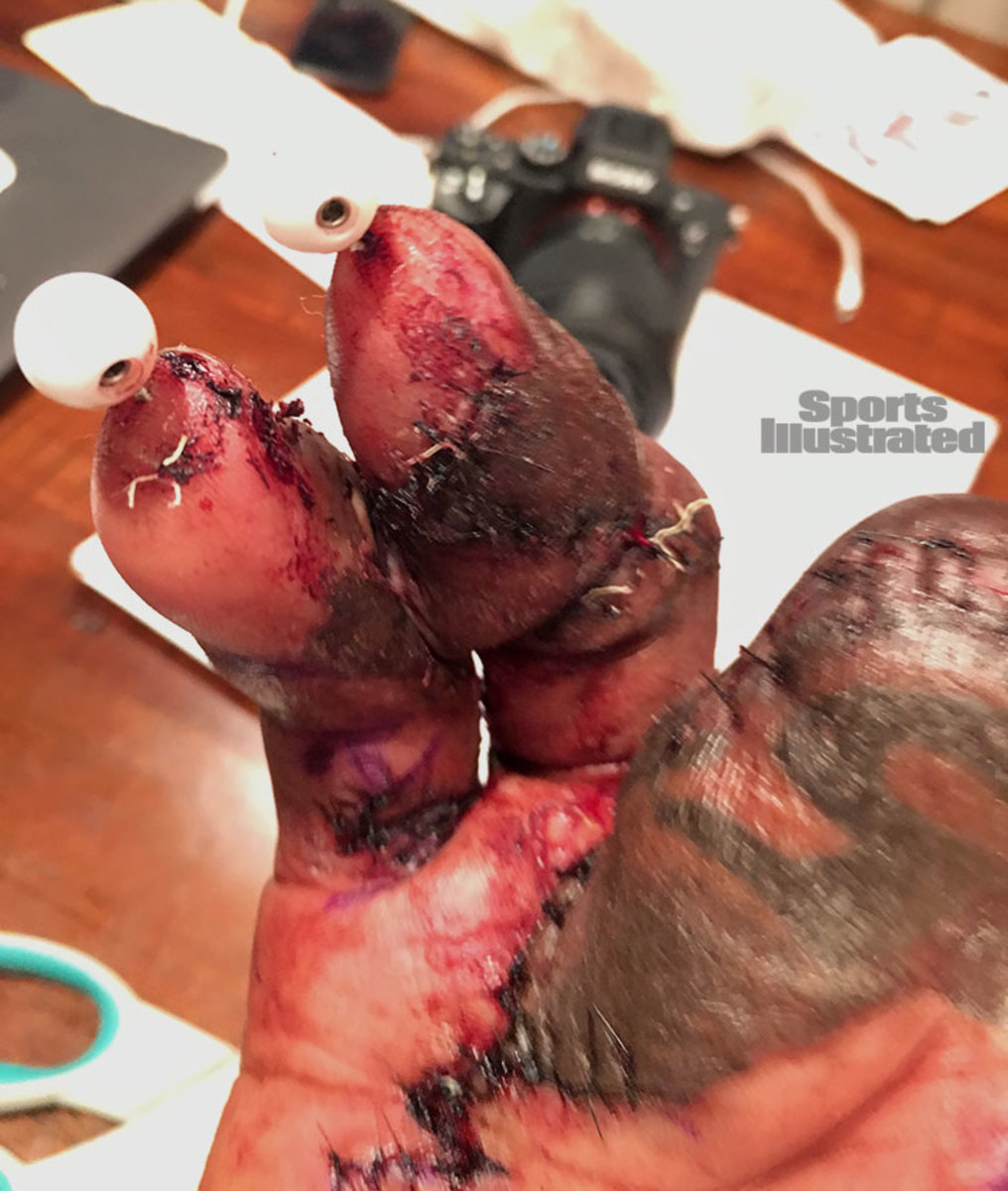
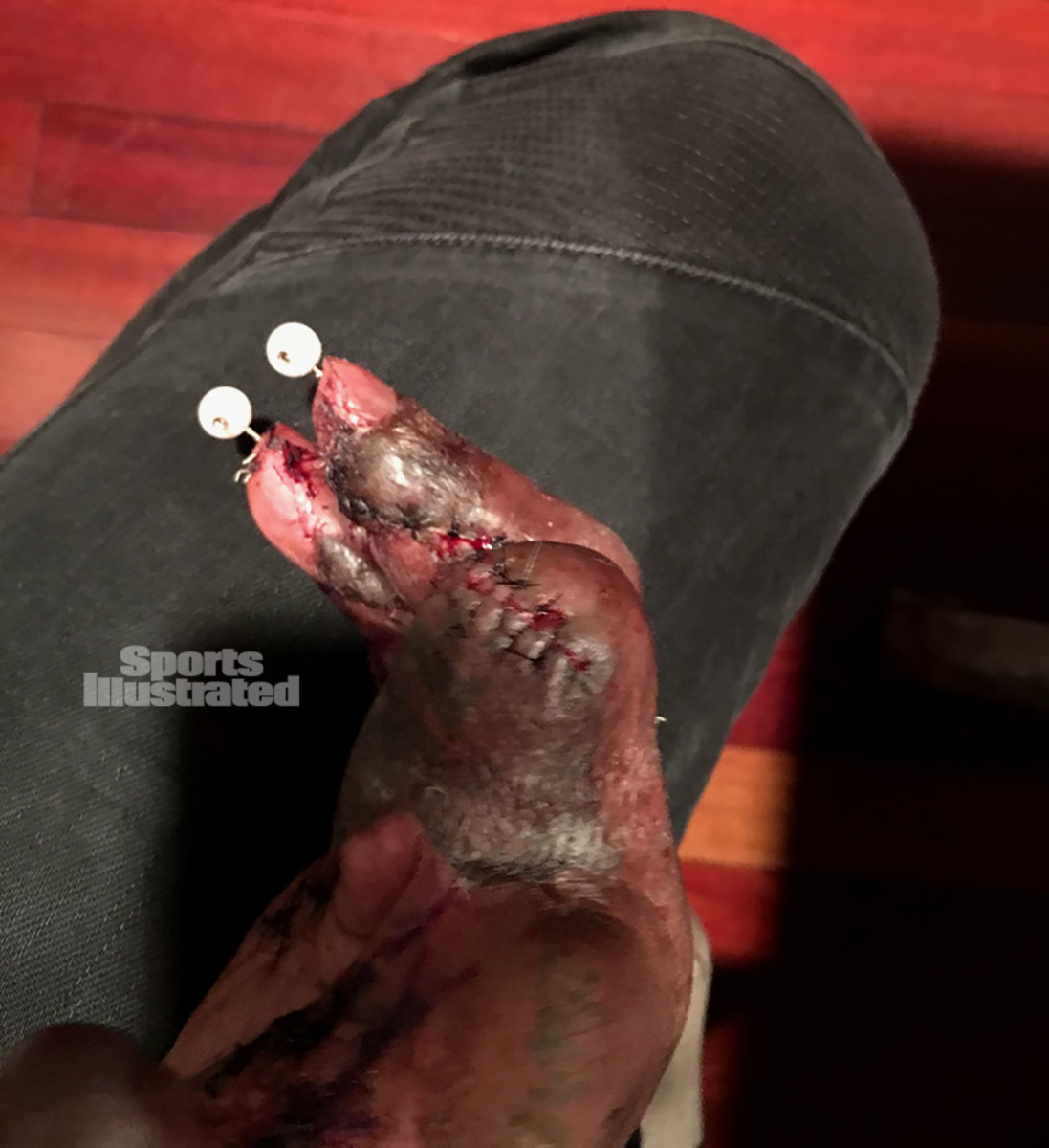
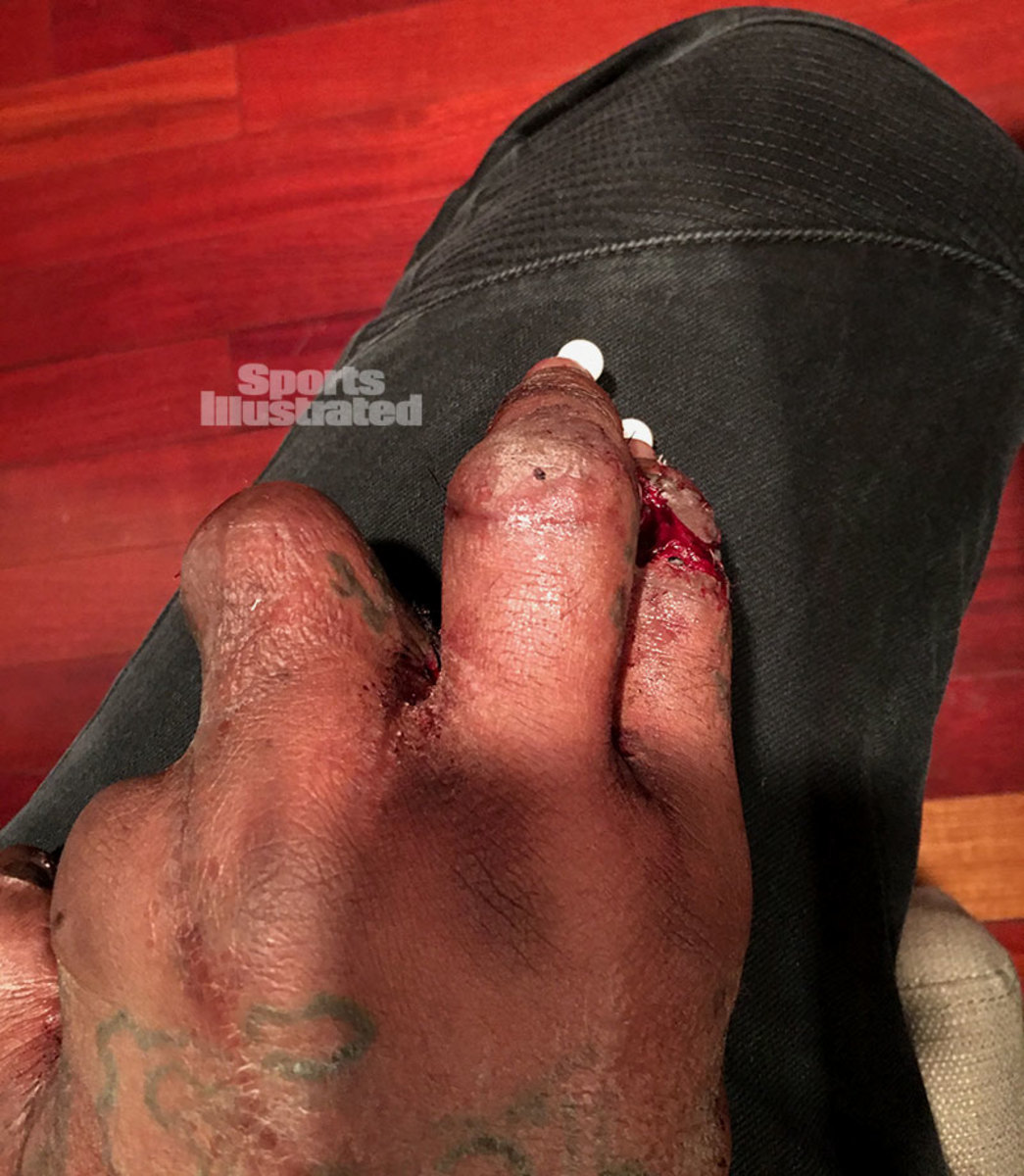
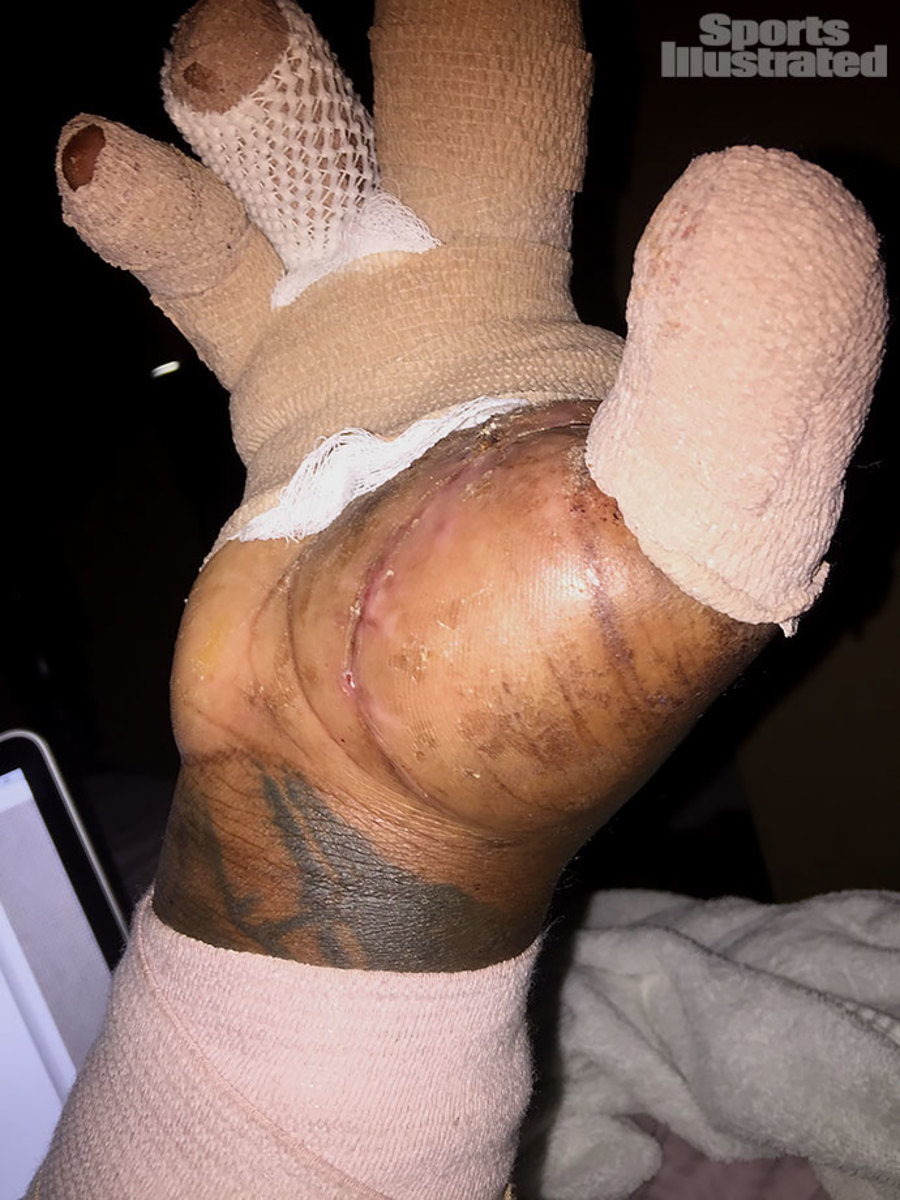
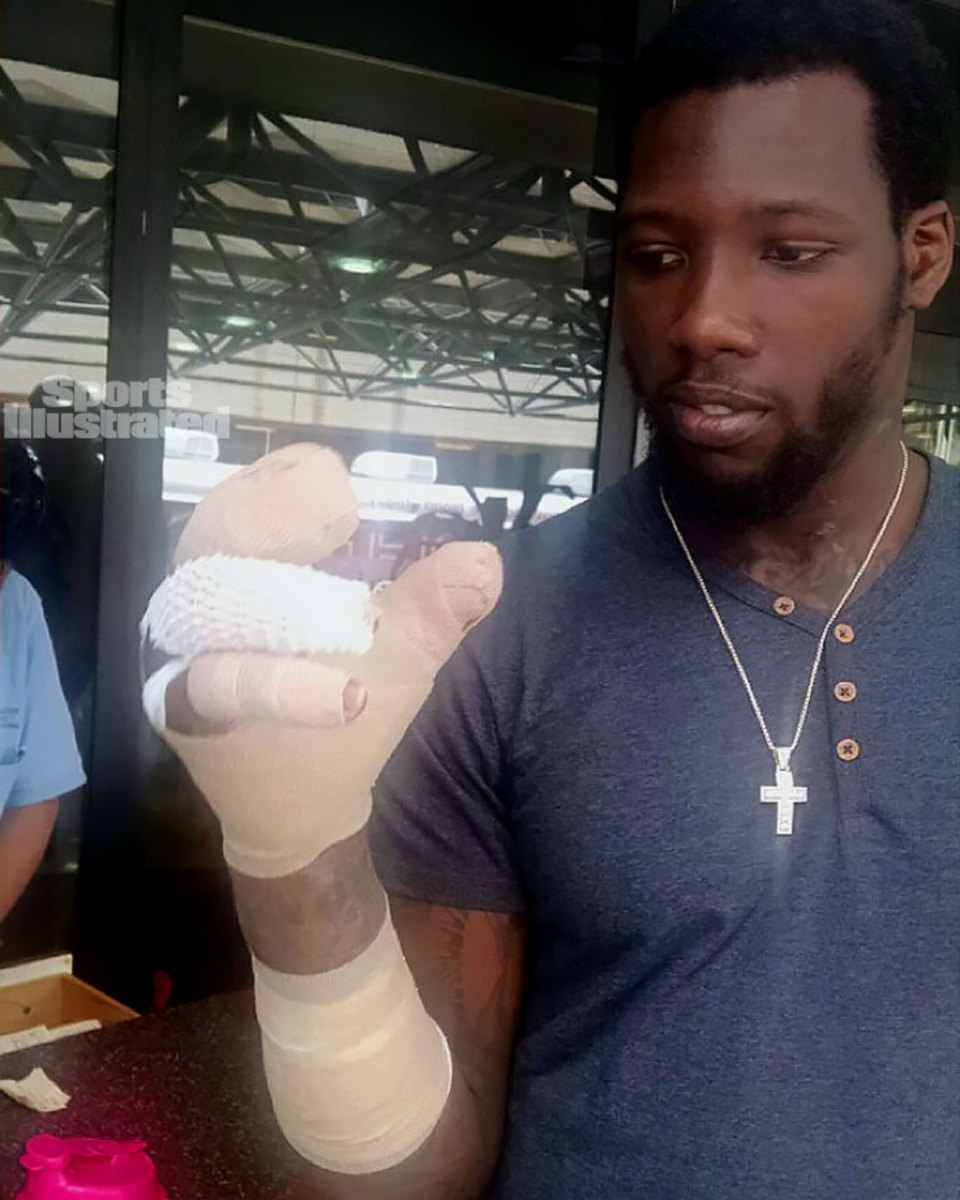
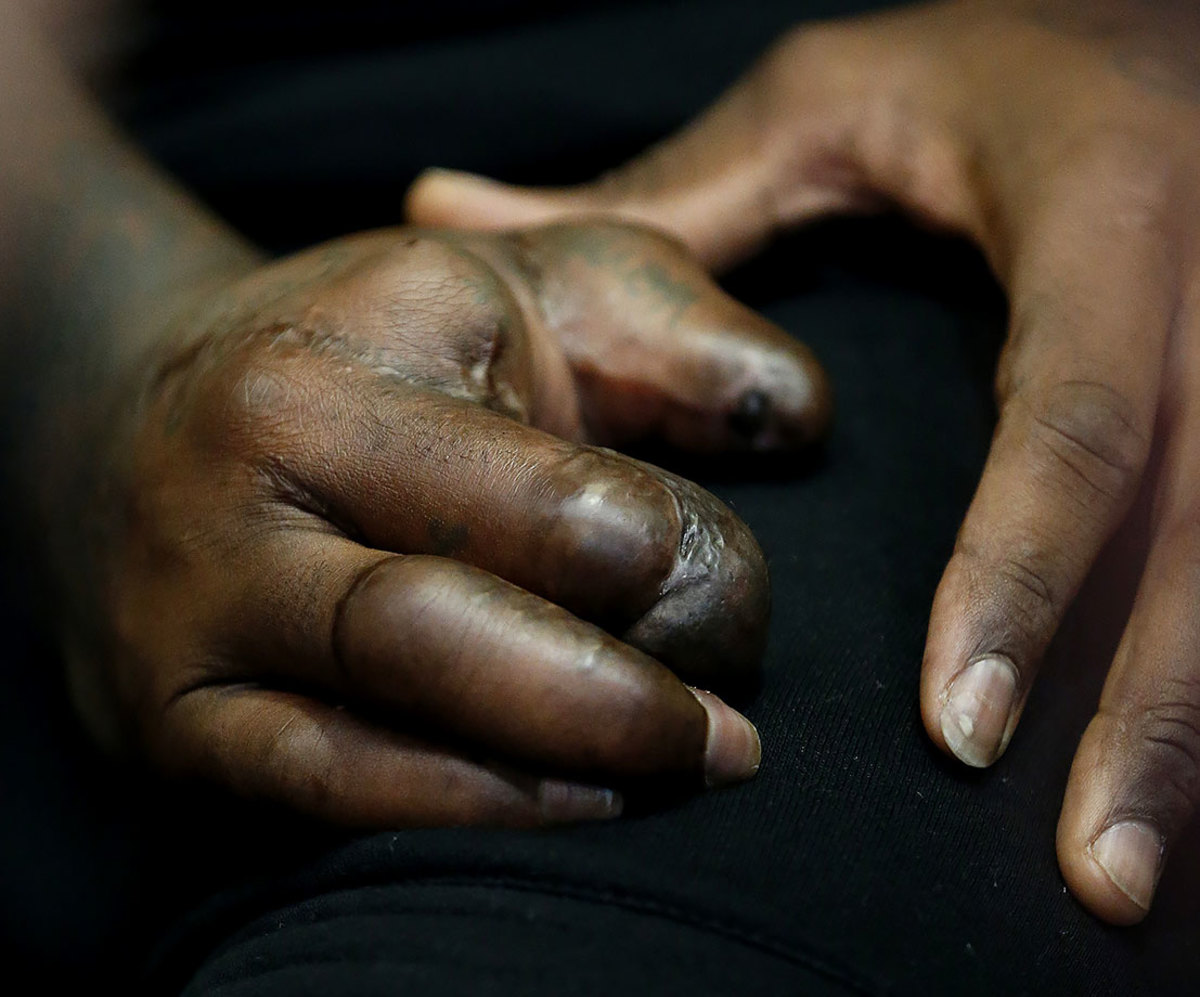
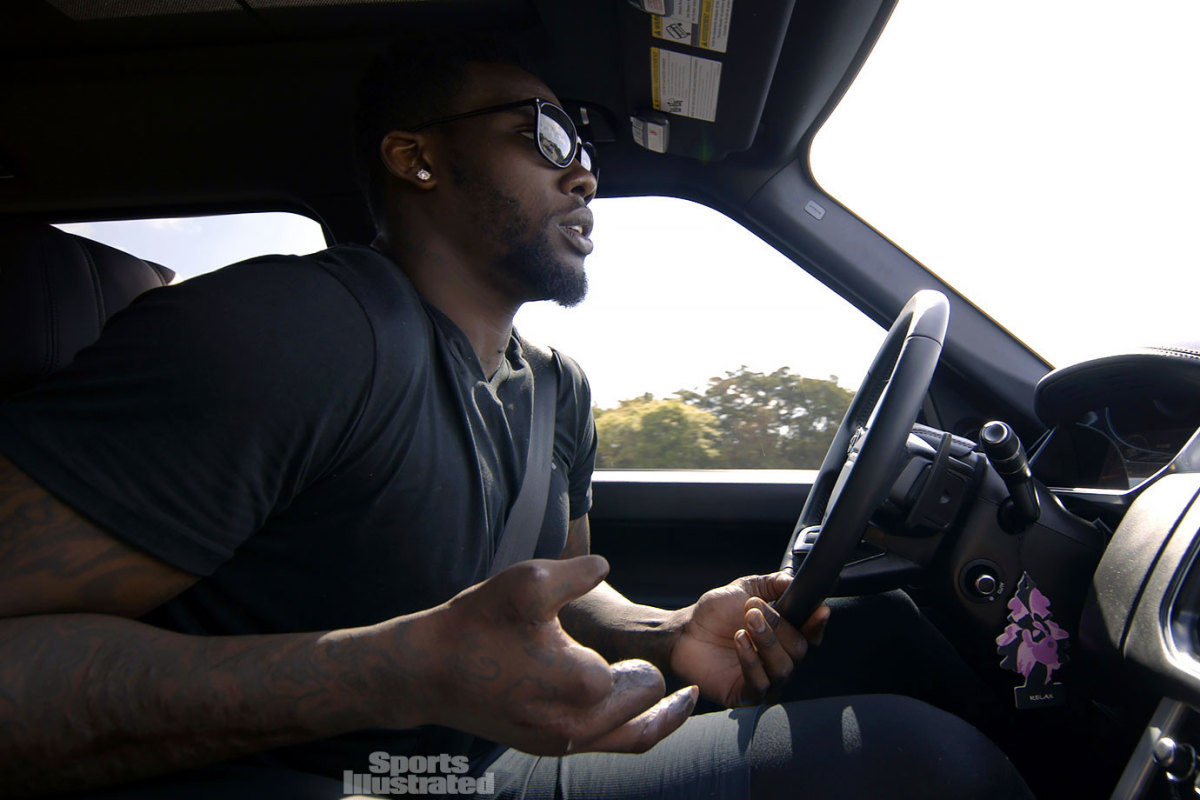
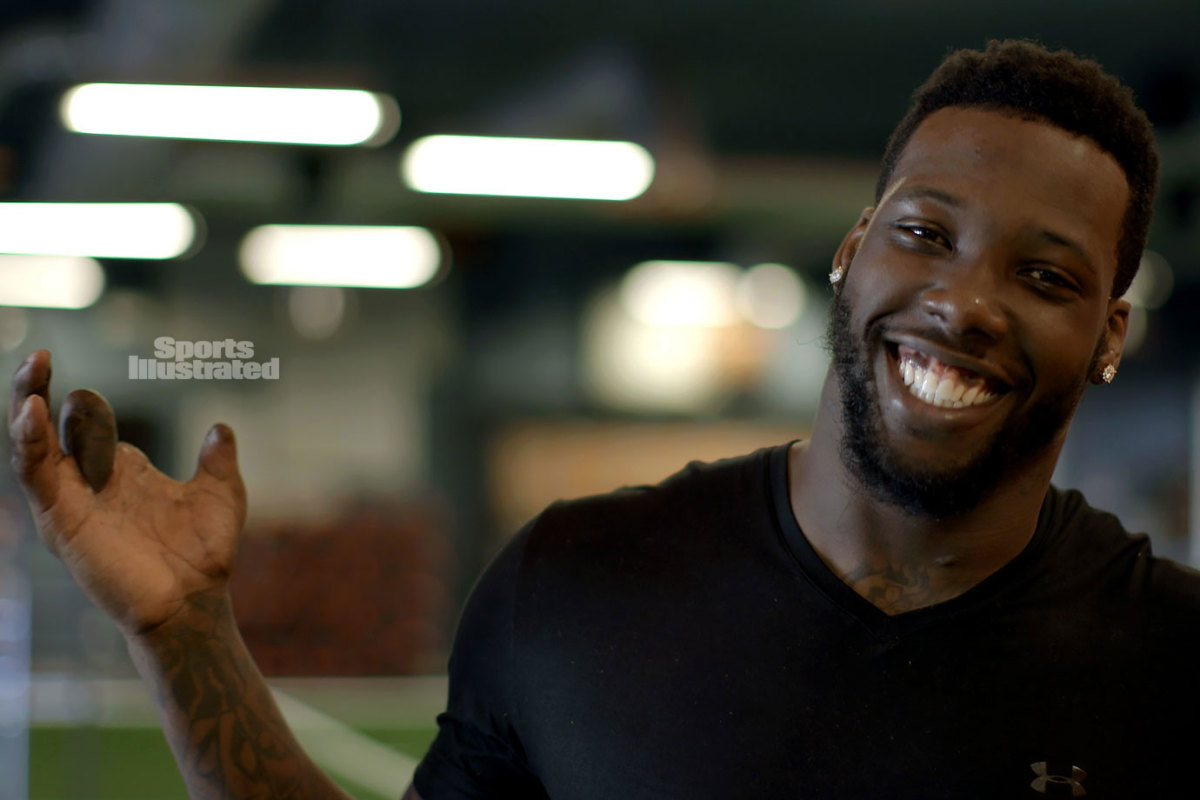
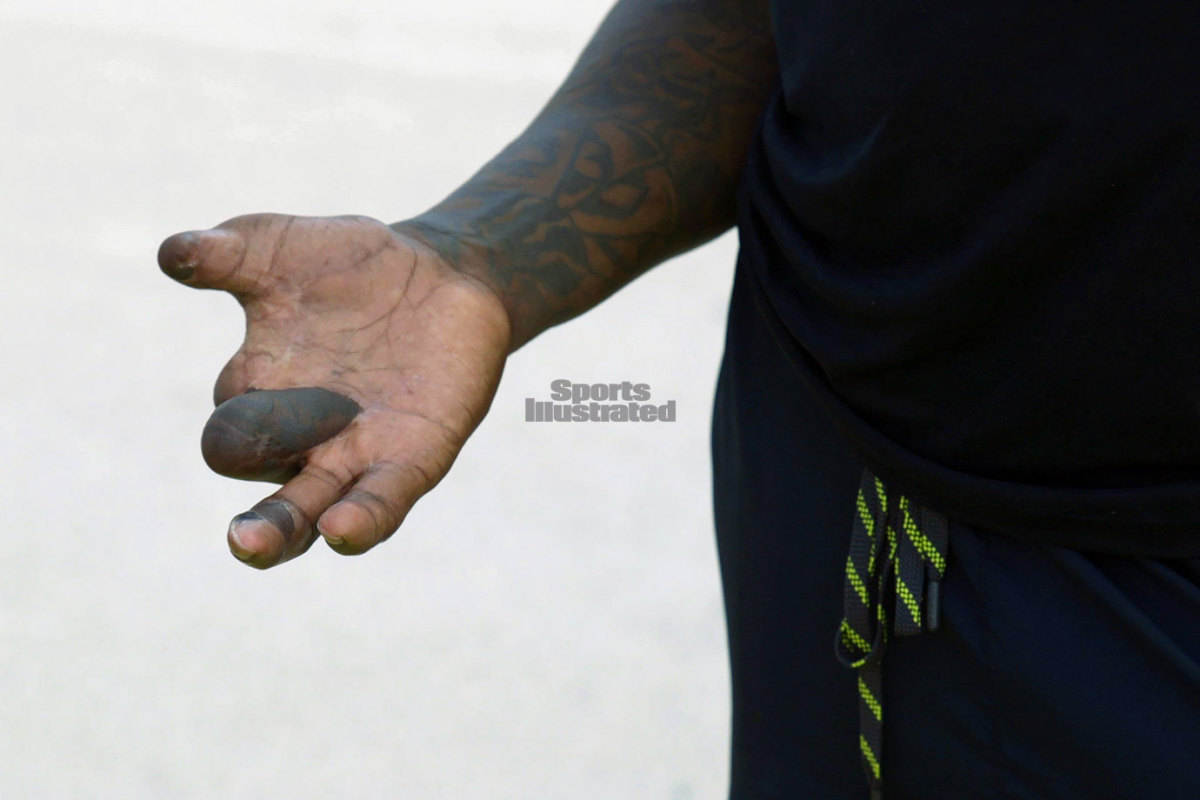
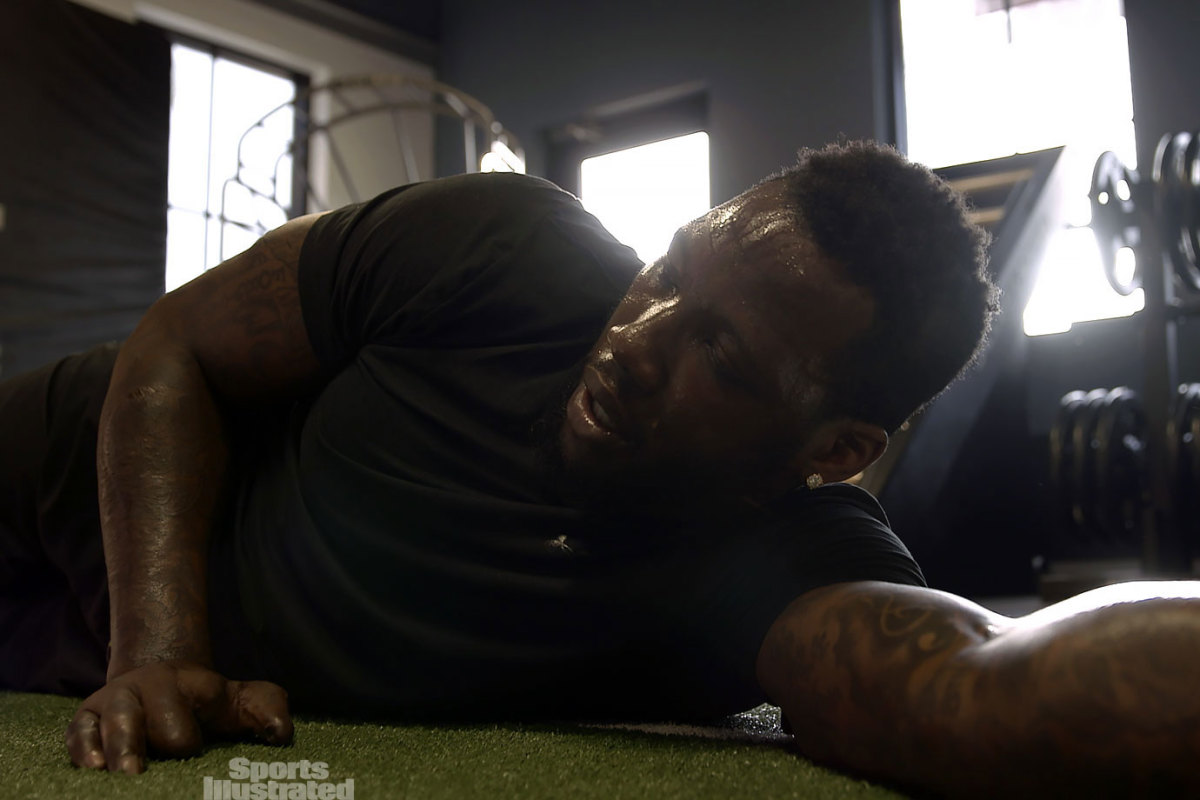
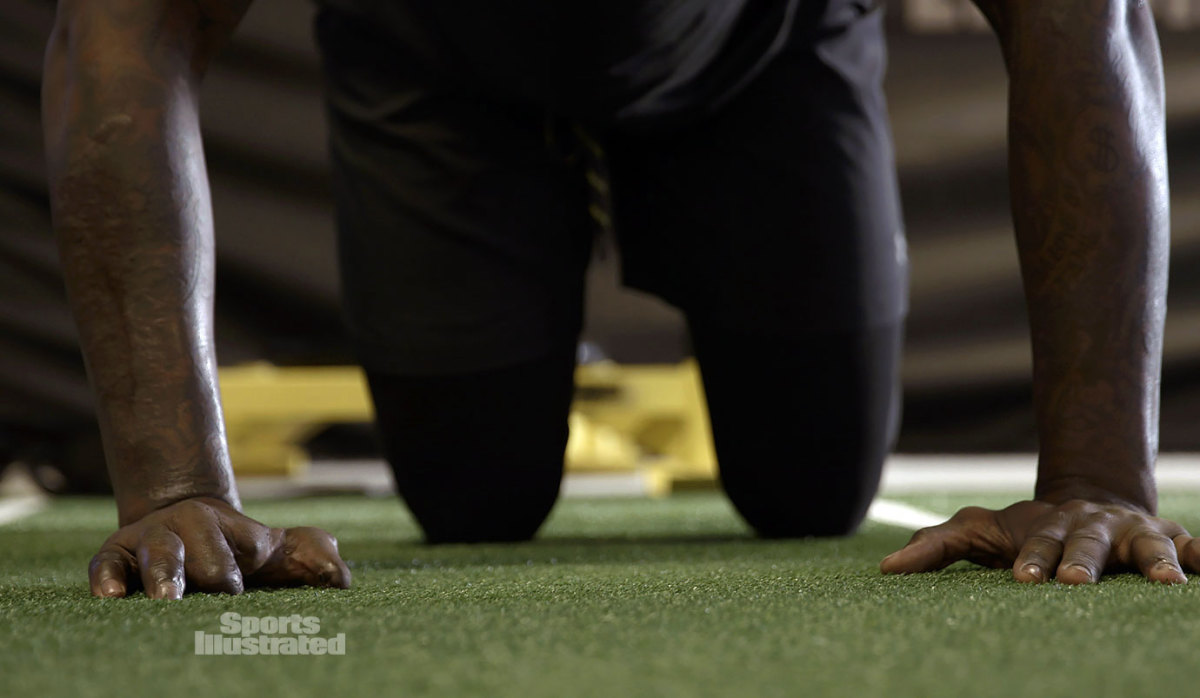
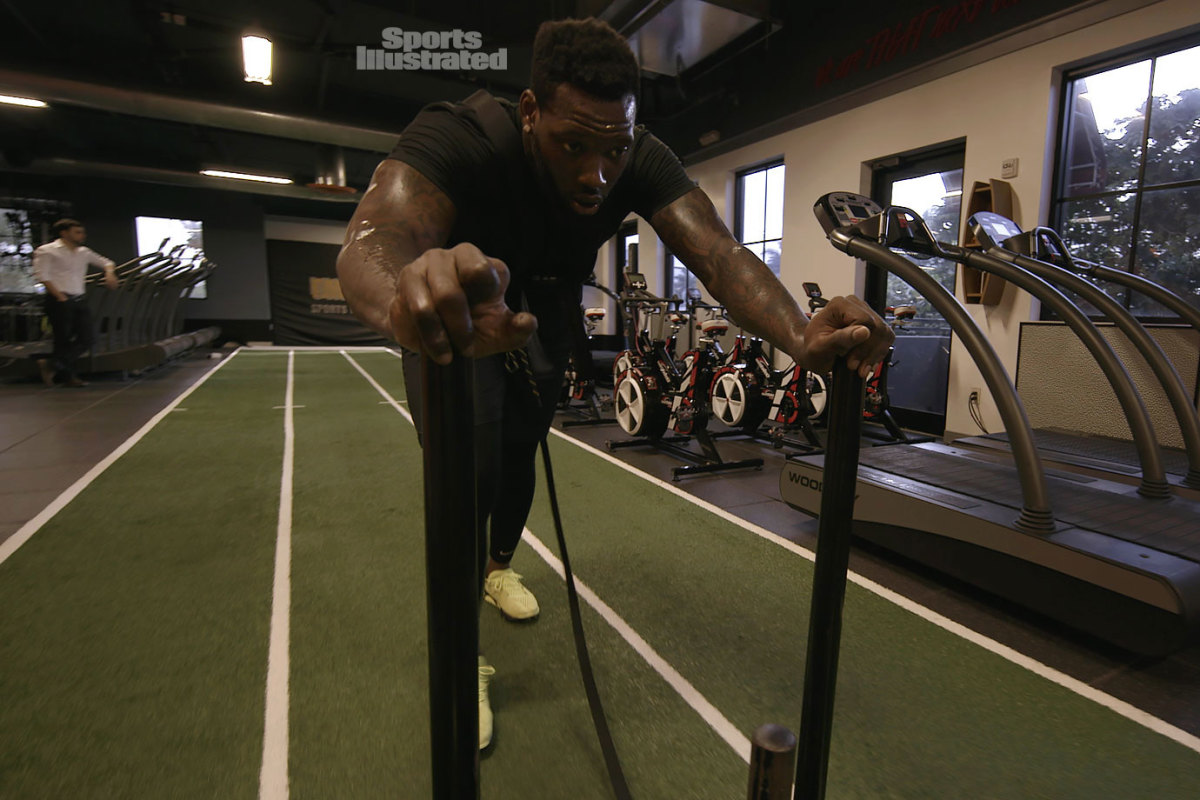
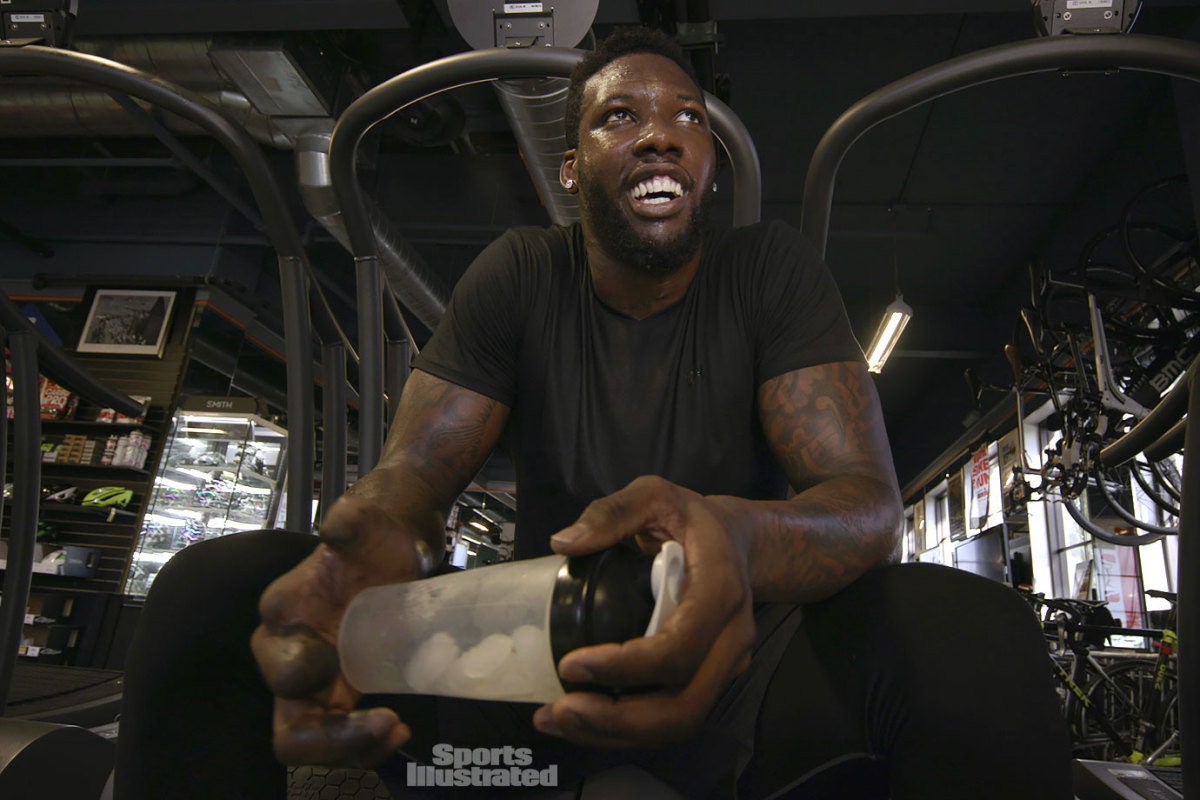
He glanced down. The street had gone black again, but Pierre-Paul could make out a sight far more gruesome and shocking than anything he’d ever glimpsed on a football field. “I’m looking at my [right] hand and I’m seeing every ligament,” he recalls. “You only see this stuff in the movies.”
In an instant he wrapped his shirt around his hand—destroyed to a degree he still could not know—and bounded toward the passenger seat of Germain’s nearby Porsche Cayenne. Inside, blood spilled everywhere, on the doors, on the seat, in the dashboard vents. The metallic smell of gore filled the car.
A friend named Tarvarus Jackson drove, weaving south on I-95 and blowing through whatever traffic lights impeded him, the 15-minute ride to Broward Health North hospital in Deerfield Beach taking just five. At his side, Pierre-Paul’s mind raced: Would he lose his career? His hand? He was hemorrhaging a lot of blood; would Josiah lose his father?
Damn, Pierre-Paul remembers telling himself as the hospital came into view. I messed up.
***
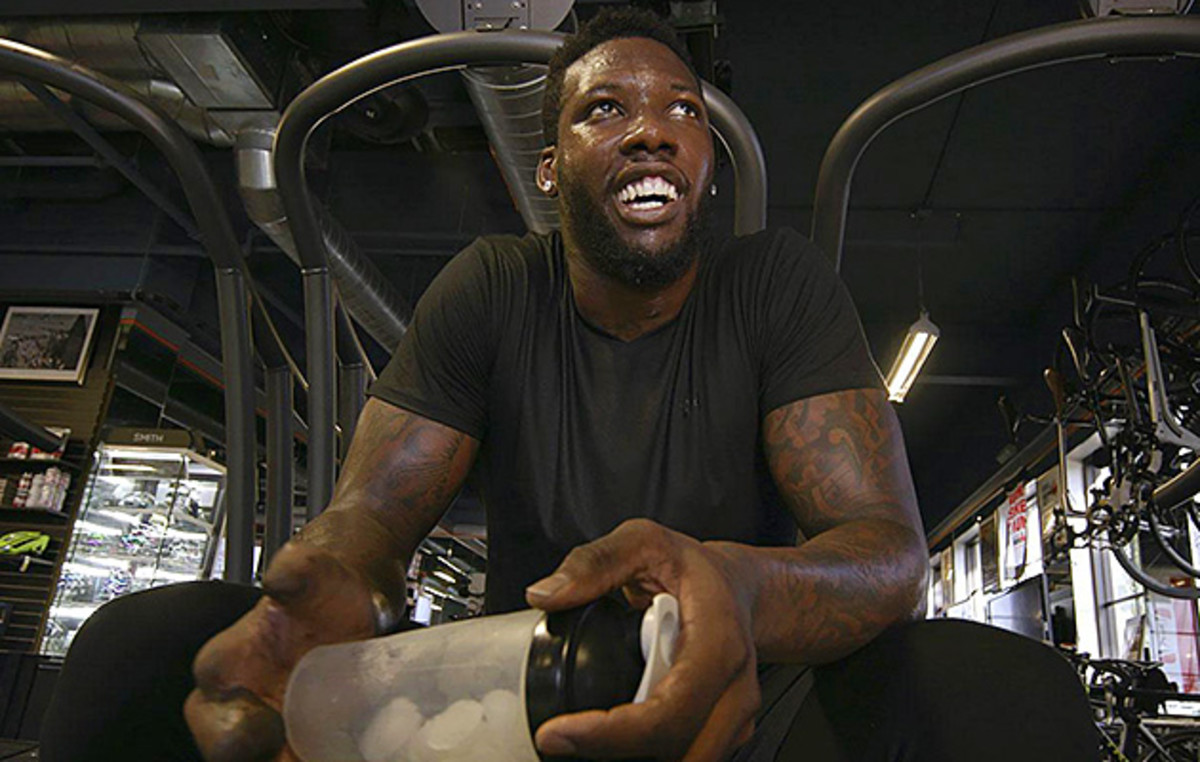
Even in the morning, the South Florida sun sizzles during early spring, but Jason Pierre-Paul doesn’t seem to notice. He grows animated in telling his story in detail for the first time to a reporter; his voice rises, and he throws his body to the ground as he reenacts his nightmare.
Pierre-Paul has returned to the place where his world forever changed, a small piece of yellowed lawn on NW 2nd Avenue, 40 miles north of downtown Miami. It has been nine months since his accident, and to him it feels an eternity away. The experience, he says, has given him a fresh view on football and life. At 27, he can hardly compare the person he was before he lit that fuse with the one he has become.
Pierre-Paul was raised in Deerfield Beach without much, the son of Haitian immigrants. His father, Jean, went blind from glaucoma and could not support his growing family; his mother, Marie, had to go to work just after Jason was born. She learned to drive, became a housekeeper and has remained one since, even as her third child’s NFL fortunes grew.
• KING: New Orleans mourns the tragic death of Will Smith
So it was that when Pierre-Paul came into a little money, he shared it. Every Independence Day since he was 15, he’d light fireworks across the street from the home of his best friend, Ezekiel Muse. As Pierre-Paul grew older and richer, the fireworks displays grew larger and more grand. They were, Pierre-Paul says, a way to give the children of his old neighborhood the excitement he longed for growing up.
How quickly a joyful occasion turned perilous. Several times in the rush to the hospital, he unwrapped the shirt to peek at his hand, which looked as if a flap had been peeled back to expose all that hid beneath his thumb, index finger, middle finger and palm. “You see all your ligaments, your tendons, everything,” he says. “I saw how the hand really is without skin on it.”
Will Smith was a good man, taken away for no good reason
Then, as Pierre-Paul arrived at Broward Health North . . . nothing. Here is the beginning of a manic period of anesthesia, emergency surgeries and pain meds so strong that Pierre-Paul says he can’t recall much of what happened next. He has had to piece together the following days from the accounts of those who were with him, a waiting room full of concerned friends, family and advisers, including his agent, Eugene Parker (who died last month), and his business manager, Danny Martoe. But Pierre-Paul remembers this: Before he succumbed to a state of semiconsciousness, he had one directive for his doctors. “Whatever y’all do, do not cut my hand off.”
Pierre-Paul was rushed into surgery, where more than a dozen pins were inserted to stabilize his injury, which included a broken thumb, an index finger that would most likely require amputation, a middle finger that would never be the same and a charred palm in need of multiple skin grafts. Horrifying photos of the aftermath, including those following Pierre-Paul's final skin graft, show a tattoo, once on the football star's forearm, now transplanted to the area surrounding his damaged middle finger.
“Jason was in excruciating pain,” says Germain. “He could barely talk; he kept moaning. He was crying, ‘Oh, my gosh. What did I do?’” Despite the violence of the explosion, all of his fingers were still technically attached to his hand—his index and middle finger by the bone, his thumb, Pierre-Paul says, by only the skin. One doctor told Germain in those first hectic hours that Pierre-Paul’s NFL career was almost certainly done.
• BEDARD: Return of the linebacker? This draft’s talented trio
Pierre-Paul’s advisers scrambled. Because of the holiday, most of South Florida’s best hand surgeons were unavailable, and with a multimillion-dollar career at stake, his camp needed them back. After one night at Broward Health, Pierre-Paul was transferred by ambulance to Jackson Memorial Hospital, in Miami, where he entered the care of a team led by Patrick Owens, an orthopedic surgeon with a history of treating professional athletes. Here, for the first time, Pierre-Paul’s reps say they were assured that both his hand and his career might be salvaged.
Lying in his hospital bed, knocked out by the pain meds, Pierre-Paul was oblivious to this semi-promising news. As were the Giants, whose representatives would quickly come calling.
***
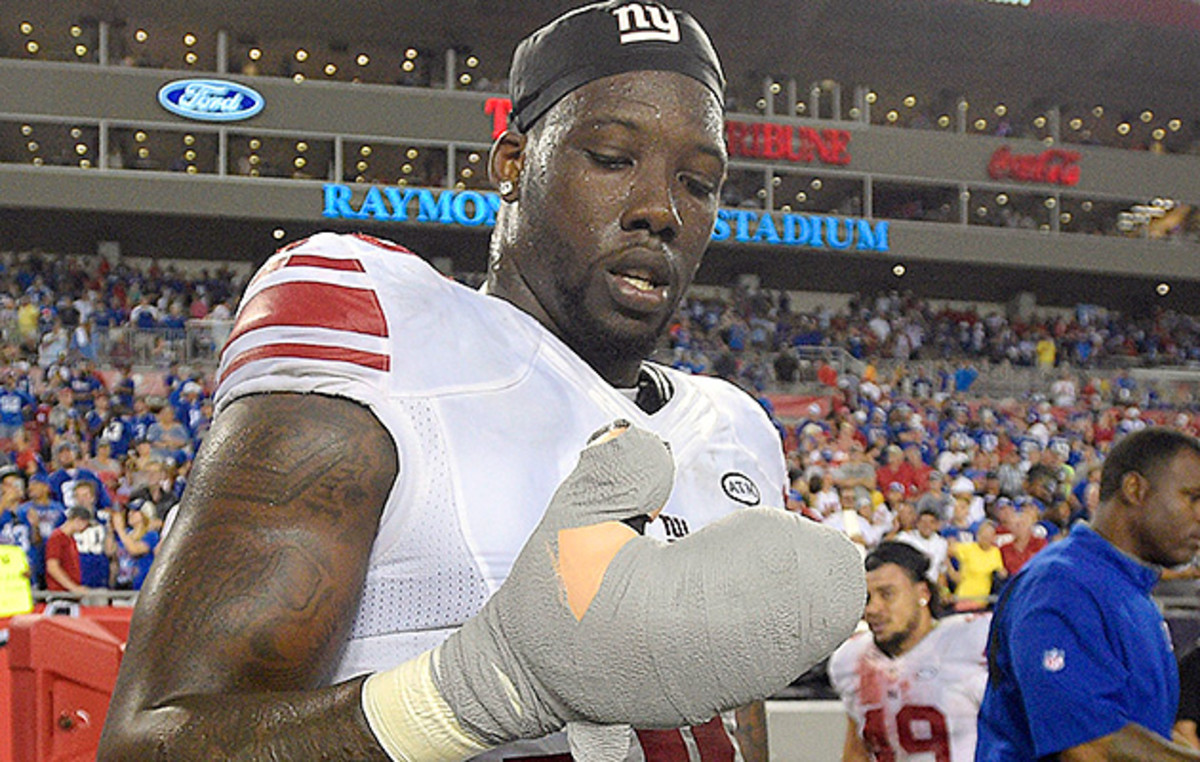
On July 6, within 48 hours of learning through social media about their best defensive player’s horrific accident, the Giants’ senior vice president of medical services, Ronnie Barnes, and team special assistant Jessie Armstead, a mentor to Pierre-Paul, flew to Miami, intent on learning the extent of Pierre-Paul’s injuries.
For both parties it was a precarious moment. New York had placed its franchise tag on Pierre-Paul four months earlier and then offered a reported $60 million extension, but at the time of the accident he still had not signed the extension. (His signature was not due until July 15; if he declined, he still would be guaranteed $14.8 million in 2015.) Even with all the uncertainty after the accident, the Giants did not immediately retract their franchise tender to Pierre-Paul, who would have become an unrestricted free agent had they done so.
At Jackson Memorial, Barnes and Armstead had to negotiate access to their player through his family and advisers. Eventually, Germain says she spoke on his behalf: She met with the Giants’ reps at a hospital Dunkin’ Donuts and told them he wasn’t ready to be seen, that he could barely communicate; often he would just moan answers to doctors’ questions, then slip back to sleep. On July 8 the New York contingent left Miami with little new information.
The drama ballooned from there. Pro Football Talk reported that Pierre-Paul had knowingly denied the Giants entrance to his room. (Pierre-Paul rejects that: “If I knew they were there, I’d be like, ‘Let ’em in.’”) And a team source told the New York Daily News, “We really don’t understand why [his representatives] won’t let us help him. What are they trying to do?” (Giants spokesperson Pat Hanlon confirms Pierre-Paul’s account.)
• FARRAR: Counting down the top 50 | BURKE: NFL draft team needs
Depending on which story you read, the injury was either very serious or not serious at all; Pierre-Paul’s career was finished or he was ready to play again. The closest thing to a real answer came when ESPN’s Adam Schefter tweeted a photo of Pierre-Paul’s medical chart that showed that his right index finger had been amputated. (Pierre-Paul later filed a lawsuit against ESPN and Schefter, seeking damages for the publication of private medical information; no hearing has been set.)
Week Under Review: What Ray Rice's daily life looks like now
From afar it all seemed like smoke and mirrors, Pierre-Paul obfuscating the extent of his injuries in order to hold on to some leverage in contract talks. But he swears he was so doped up during the days following his accident that he only later learned, on TV, about the Giants’ visit. “People say he was hiding, dodging,” says Germain. “It’s not like Jason was enjoying hospital food, lounging.” When asked whether he could have been more forthcoming about the extent of his injury, Pierre-Paul stands firm: The decision his inner circle made on his behalf was the right one. “My family is gonna go off what they think is best for [us],” he says.
Pierre-Paul stayed in the hospital for two-and-a-half weeks, uninterrupted. On July 14 he watched from his room as news reports said he’d been sent home. And in one way it was true that Jason Pierre-Paul was no longer a patient at Jackson Memorial: That’s because for much of his stay, to avoid media attention, Pierre-Paul says he was checked in under a fake name that his medical staff conjured up: Don X.
Two and a half weeks is a tough amount of time for any person to spend in a hospital, especially a finely tuned athletic freak like Pierre-Paul. Ultimately, he endured so many hand operations—eight in the hospital, two later—that he began to waste away in his bed. He tried his best to stay in shape, yanking out his IV and enlisting a nurse to climb flights of stairs alongside him, but there was only so much he could do. By the time he was released, on July 22, he had shed 30 pounds.
***
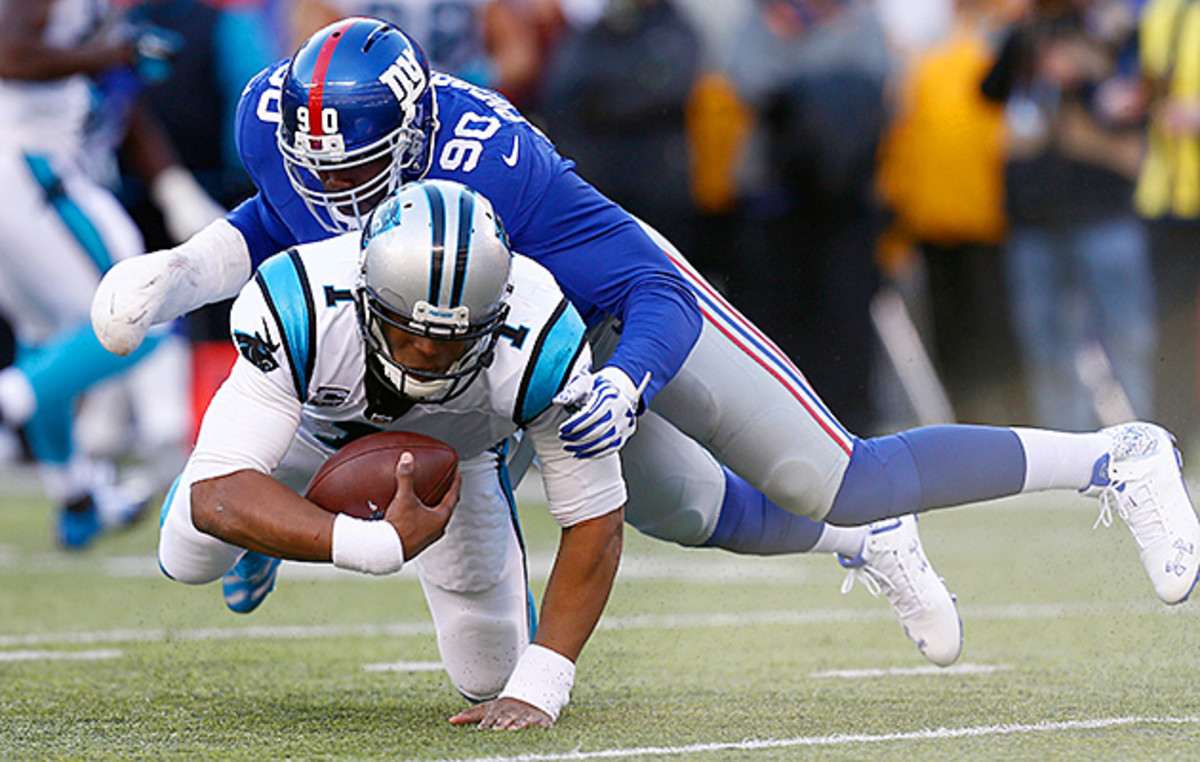
Seven weeks later, on Sept. 7, Pierre-Paul flew commercial from Fort Lauderdale to Newark for his first meeting with the Giants since the accident. There he says he was welcomed by a supportive room—owner John Mara, general manager Jerry Reese and coach Tom Coughlin—eager to see him return to health. It was a short, informal catch-up, but Pierre-Paul says he was buoyed by the visit. He believed he was ready to return to the field.
Team doctors thought otherwise. New York held off on signing Pierre-Paul until Oct. 27, at which point the desperate Giants—31st in the NFL with just 8 sacks at that point—finally presented an incentive-laden offer for the remainder of the season: $1.5 million guaranteed, with a chance to earn $7.2 million more. Even if he achieved a series of ambitious incentives, Pierre-Paul would make, at best, half his original franchise-tag money.
In the meantime he worked with trainer Mike Alessi at the IMPACT Sports Performance gym in Boca Raton, pushing sleds with his bandaged hand, pounding whatever weights he could, working the dexterity in his hand and rebuilding the atrophied muscles in his arm.
• EDGE: How Pierre-Paul got back into football shape
In Week 9, after only three days of practice and wearing a monstrous padded club over his right hand, he debuted against the Buccaneers and made two tackles. He returned at 265 pounds, having regained nearly two-thirds of the weight he lost in the hospital, but too often he found that he wasn’t himself on the field.
During his second game back, a Week 10 matchup against the Patriots, the bone in his middle finger came out. Doctors had to then trim the bone and sew it back in.
In Week 15, Pierre-Paul chased down Cam Newton, certain that he could strip the Panthers’ QB—but his reach was clumsy and his clubbed right hand jabbed Newton in the shoulder instead.
The Giants went 2–6 with Pierre-Paul on the field and failed to make the playoffs. One year after he’d racked up 12.5 sacks, helping the team rank fourth in the NFL with 47, Pierre-Paul had just one, and New York finished 30th with 23. It is fair to question whether the 2011 All-Pro, who averaged 8.5 sacks in his first five seasons, will ever become one of the NFL’s most feared linemen again.
***
“When I look in the mirror, I’m happy. Thank the Lord—it could have been worse.”
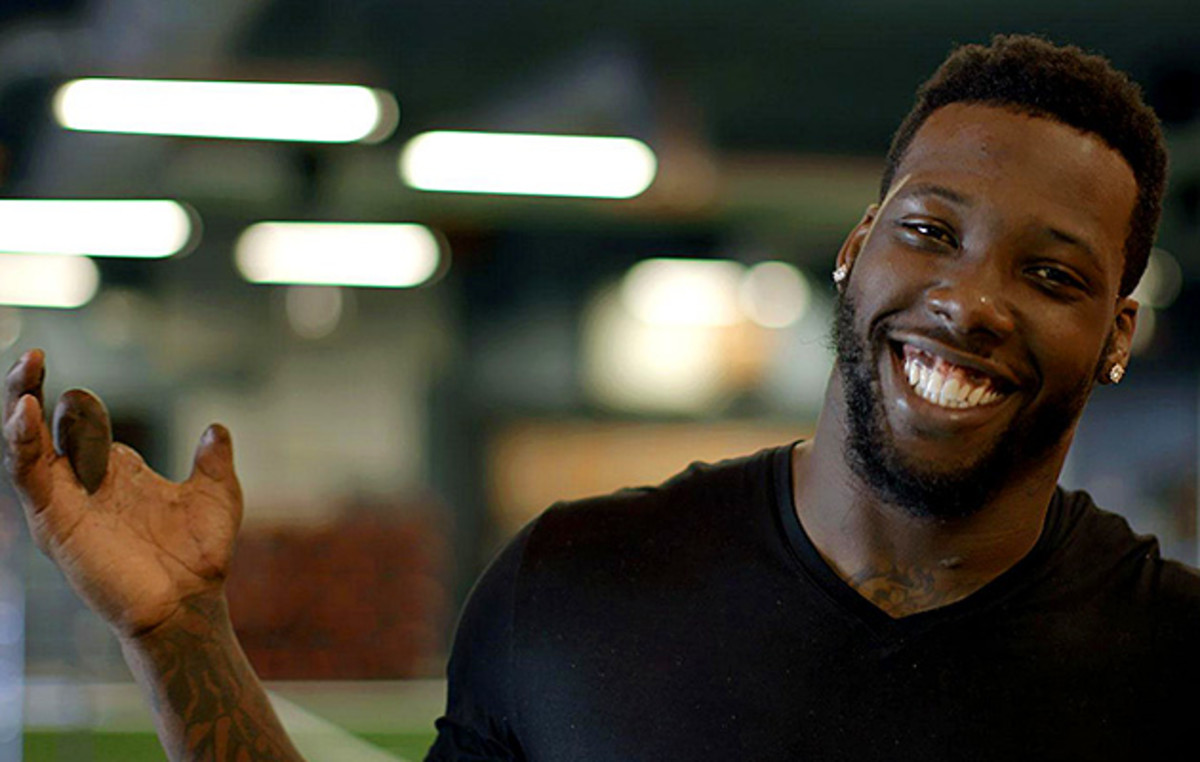
Pierre-Paul sits in the foyer of his yellow Spanish-style home in Boca Raton, Fla., recounting all the little things that have changed in nine months. Putting in his two massive diamond-stud earrings? That’s tougher these days. Wiping his glasses? More difficult still. Buttoning his shirt? Tricky at first, but easier now after all the rehab, the continued care of specialists—and a trip to the tailor. In place of a button on the left cuff, all of his dress shirts now have snaps.
The hand remains a curiosity, a hardened, scarred appendage crisscrossed with burn marks. He gets looks. He knows that every handshake henceforth will be met with uneasy eyes. But it’s no badge of shame. “I have no regrets at all [about the accident],” he says. (Pierre-Paul was never charged in Florida, where fireworks that explode are prohibited.) Instead, he points to how it has changed him. “I carry myself differently. I look at things differently. I try not to put myself in horrible situations anymore. I have a lot of people depending on me—even people I didn’t know depended on me.”
Among these are the ones he meets through social media, where he’s lately ramped up his presence on Twitter and Instagram, sharing photos and videos of his hand and his rehab. Pierre-Paul says he receives messages all the time from people with disabilities and amputations far worse than his; they thank him for helping them get out of bed in the morning.
On his first day out of the hospital, last July, he was having his car washed when he met a man who’d lost his entire arm in a motorcycle accident. Pierre-Paul was struck when the stranger noticed his damaged hand and asked, “How are you doing?”
How am I doing? Pierre-Paul said to himself. He began to feel fortunate that his accident hadn’t been worse.
Pierre-Paul has owned his mistake, going so far as to delete from his phone and social-media feeds every image of himself from the days when he had all 10 digits. “I could dwell on it, like, Damn, I wish I had that finger,” he says, “but when I look in the mirror, I’m happy. Thank the Lord—it could have been worse.”
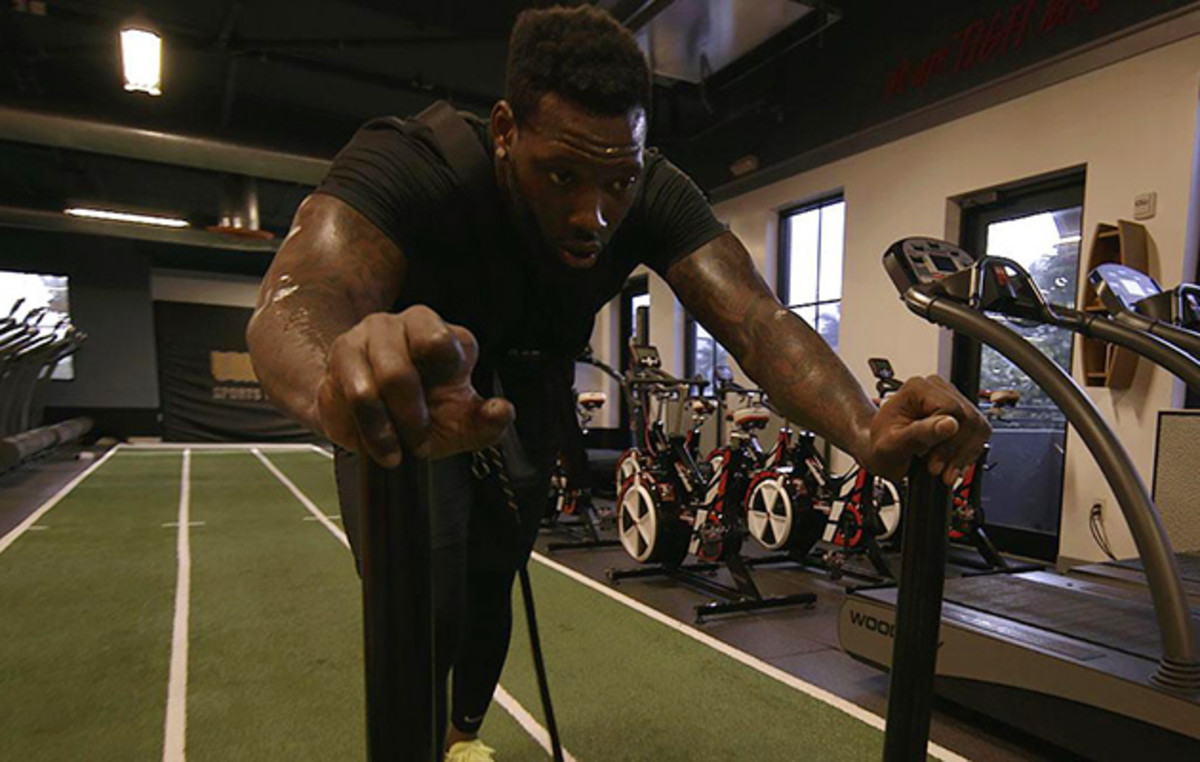
After signing another one-year show-me deal with the Giants on March 8—payable up to $10.5 million, with $4.25 million guaranteed; damaged hand and all, a pass rusher such as Pierre-Paul is hard to find—he’s training furiously this spring. He has a special wrist strap fitted with hooks to help him lift weights, and he has stocked his locker with two items that he believes will help him be an All-Pro again. The first is a special glove, custom-fitted by Under Armour for his right hand. Mercifully, he’s been given the green light to ditch the club that hampered him last season.
Beside it, a hospital wristband. It tells Pierre-Paul all he needs to know about responsibility, about mistakes and how they can turn a man to rubble or help shape him instead. Neatly printed across the tag, which he’ll look at before every game this year, is a name. don x.
